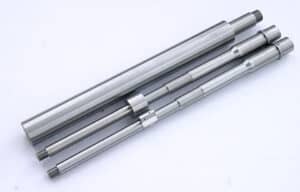We’ve all heard the “Just as good!” notions from internet gunsmiths. Casuals will regularly circulate the myth that building a quality AR is as simple as pushing two pins to mate an upper and lower receiver. Candidly, entrusting the technical installation procedures of a rifle’s critical components to a budget-friendly third party may result in a malfunctioning rifle at best, or a rifle that fails catastrophically at worst.
One all-too-common failure point of the internal piston AR-15 stems from the gas block. The gas block directs propellant gasses from the fired cartridge to cycle the action. Naturally, if the gas block is improperly installed, it may restrict or redirect the gasses away from the action, thus causing malfunctions. Therefore, it is crucial to install a gas block with due diligence and thorough oversight.
A contemporary low profile gas block will be injection molded or cast out of some steel correlate. Secured by two small set screws, the gas block’s ability to seal and direct gasses to the system is reliant upon its manufacturing tolerances (how tight it hugs the barrel) and how well the set screws can grip the round surface of the barrel. This may seem counterintuitive; how are screws supposed to dig into a round, convex surface?
Sadly, your bullshit meter is not misfiring. Run-of-the-mill ARs will have oversized gas blocks poorly fitted onto barrels where they will loosen, shift, and restrict gas pressure needed to cycle the action. Some manufacturers have elected to “dimple” the barrel to create concave points where the fasteners can dig into respective holes, thus reducing shift. This process works, albeit still reliant upon the tolerances and materials of the gas block, the torque applied to the set screws, and whether thread locker was applied to keep said screws from loosening under the heat and vibration of the firing sequence.
By far the most secure of gas block installation procedures is drilling and pinning in place. The block is aligned and torqued with set screws, then the barrel and gas block are drilled, reamed, and an oversized cross pin is pressed into place, thus preventing the gas block from shifting under load. This process is still reliant upon the materials used and the tolerances of the block. If the block was easy to slide onto the barrel, then the high velocity propellant gasses will partially escape from the block, thus reducing positive pressure into the system. If the gas block and the barrel were made of different steels, then the respective thermal expansion properties may differ, thus causing undue stress on the system and potentially increasing gas loss during the firing cycle. This process is also time and labor intensive, and rarely comes as an OEM offering.
Enter the HM Defense MonoBloc barrel. This patented unit features an integrated gas block machined from the same chunk of steel used to make the barrel. The method is fascinating: First, HM turns down a solid carbon steel blank to shape the exterior profile. The barrel is subsequently placed into a six-axis CNC and the gas block is formed through a series of computer-directed drilling and machining processes. This procedure creates the lowest profile gas block in its class; no mounting hardware is needed as the gas block is the barrel. You obtain perfect gas block alignment, zero thermal expansion shift, zero gas loss, and none of the installation headaches. Most importantly, you receive peace of mind. Nothing is going to prevent your AR from losing gas port pressure when you need it most.
Our pièce de resistance is exclusive to Lead & Steel. We receive these barrels “in the white” where they are sent to our world-class plating facility to undergo the chrome plating process. This process applies a layer of chromium into the inner surface of the barrel steel and considerably improves fatigue strength (resistance to dynamic loading), wear resistance, and corrosion resistance. Paired with our in house manganese phosphate finish to further improve rust resistance, the added surface hardness of our chrome barrels triple the expected barrel life, leaving you with a service life upwards of 40,000 rds. Talk about longevity.
To conclude: The modern gas block is dead. The MonoBloc is here to stay. Pre-orders are live, and more barrel lengths and calibers are being developed every day. Consider us for your next build.
As always, stay sharp.
-Ahmad






Comments are closed.